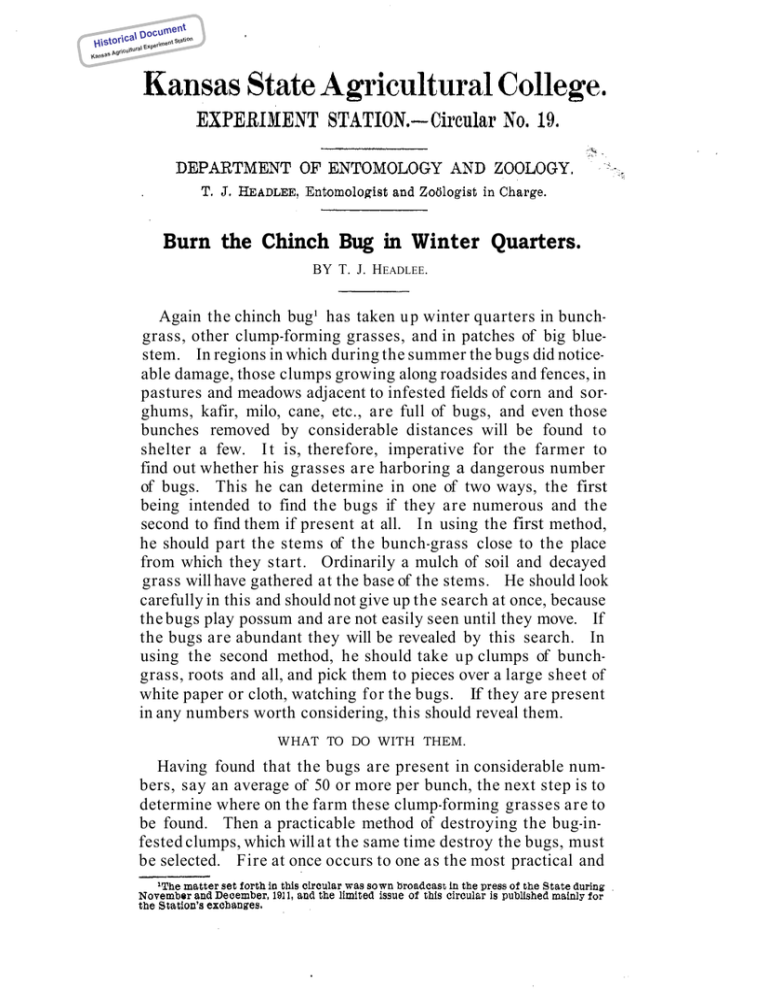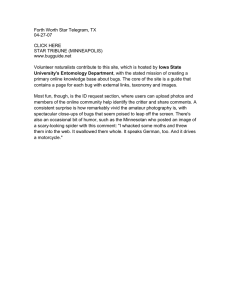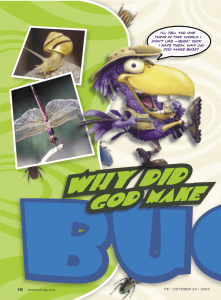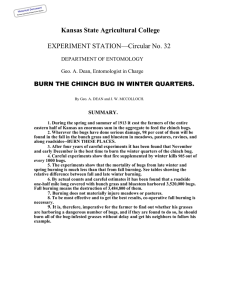Burn the Chinch Bug in Winter Quarters.
advertisement

ument c cal Do Histori n t Statio perimen tural Ex Agricul Kansas Burn the Chinch Bug in Winter Quarters. BY T. J. HEADLEE. Again the chinch bug¹ has taken u p winter quarters in bunchgrass, other clump-forming grasses, and in patches of big bluestem. In regions in which during the summer the bugs did noticeable damage, those clumps growing along roadsides and fences, in pastures and meadows adjacent to infested fields of corn and sorghums, kafir, milo, cane, etc., are full of bugs, and even those bunches removed by considerable distances will be found to shelter a few. I t is, therefore, imperative for the farmer to find out whether his grasses are harboring a dangerous number of bugs. This he can determine in one of two ways, the first being intended to find the bugs if they are numerous and the second to find them if present at all. I n using the first method, he should part the stems of the bunch-grass close to the place from which they start. Ordinarily a mulch of soil and decayed grass will have gathered at the base of the stems. He should look carefully in this and should not give up the search at once, because the bugs play possum and are not easily seen until they move. If the bugs are abundant they will be revealed by this search. In using the second method, he should take u p clumps of bunchgrass, roots and all, and pick them to pieces over a large sheet of white paper or cloth, watching f o r the bugs. If they are present in any numbers worth considering, this should reveal them. WHAT TO DO WITH THEM. Having found that the bugs are present in considerable numbers, say an average of 50 or more per bunch, the next step is to determine where on the farm these clump-forming grasses are to be found. Then a practicable method of destroying the bug-infested clumps, which will at the same time destroy the bugs, must be selected. Fire at once occurs to one as the most practical and t cumen cal Do Histori ultu as Agric n Statio riment ral Expe Kans efficient agent to be employed for this purpose. Obviously fire must destroy the bugs in one or both of two ways: First by killing them directly, and second, by destroying their cover and leaving them exposed to the rigors of winter. The first method requires either that sufficient heat shall be generated to effect their destruction or that they shall actually be partly or completely consumed by the fire. The former requires an unusually hot prairie fire, such as might result from the consumption of a heavy cover, while the latter requires close burning-consumption of the stems to within about half an inch of the crown. The prime requisite, then, in firing infested clumps of grass, is so to handle the fire as t o make it burn close to the crown from which the stubble grows. The type of firing which gives this desirable result appears to vary with weather conditions and must be selected by the individual farmer at the time of treatment. The bug-infested grasses should be burned late in the fall or early winter because most of those bugs not killed by the fire per- t cumen n io cal Do Histori tural Experiment Stat Kansas Agricul t cumen cal Do Histori Kansas Ag n t Statio perimen ral Ex ricultu ish from exposure, and because, owing to the greater dryness of the grass and consequent more nearly complete consumption, a much larger percentage is destroyed. While burning during I910 at Conway Springs did not apparently injure the yield of pastures and meadows, burning of such areas each year is not recommended, but where they harbor a menacing number of bugs, they m a y be burned every third or fourth year. Experiments are now in progress to determine the effect of burning pastures and meadows year after year. t cumen n io cal Do Histori tural Experiment Stat Kansas Agricul ument c cal Do Histori Kansas tural Agricul n t Statio en Experim For the first time in the history of warfare against the chinch bug in Kansas, the great value of winter burning has been demonstrated in a large, practical way. Last fall, for the purpose of determining the value of this measure, an area of 25 square miles in northern Sumner county was selected. This particular area was chosen because the farmers were willing to coöperate and the bugs were sufficiently numerous for a good test. This area is composed of individual farms of various sizes, and the roadsides, fence rows, pastures, meadows and waste places were covered with a vigorous growth of dry grass, the characteristic feature of which was bunch-grass. I n the bunch-grass (Andropogon scoparius) everywhere and in the big bluestem (Andropogon furcatus) was an enormous number of bugs, the former averaging 1000 per clump. I n a strip of fence row 6 feet wide and ½ mile long there were more than 3½ million bugs. This statement is based on the following facts: (1) clumps of bunch-grass averaged 1000 bugs apiece; (2) clumps of bunchgrass averaged 1 clump per square yard: (3) the big bluestem was widely enough distributed and harbored enough bugs to furnish as many as were found in bunch-grass. I n an area half a mile long by 6 feet wide there would be 1760 clumps of bunch-grass. These at the rate of 1000 each would shelter 1,760,000, and the number in bunch-grass plus that in big bluestem makes 3,520,000 bugs. Of course, a few bugs established winter quarters under ail sorts of cover, but these, as the preceding table shows, practically all perished before spring and only those bugs which quartered themselves in bunch-grass and big bluestem survived the winter in sufficient numbers to work serious harm. During the months of November and December, 1910, a rectangular block, 3½ miles wide by 5 miles long, was stripped of its chinch-bug cover by fire and the remaining 7½ square miles were more or less completely burned. Although the burning was not as close as was desired, the average length of the stubble being 1.5 inches, whereas it should have been less than 1 inch, an average of 738 bugs out of every thousand present when the firing began were destroyed, and this mortality was raised to 984 per thousand by the first of the following March, Fire supplemented by the minter destroyed 98.4 per cent of the total number that established winter quarters in bunchgrass and big bluestem. There were a few instances where, owing t o the attitude of the landowner, or tenant, burning could not be ument c cal Do Histori riment Expe ultural Station Agric Kansas accomplished, and the bugs from these places, together with those from outside the territory and a few from the burned stubs, were the ones found later in the season feeding and reproducing in the burned area. About 65 per cent of all the bugs that started the winter in unburned bunch-grass and big bluestem perished. LARGER CROP O N BURNED AREA. From the time the bugs appeared in the wheat in the spring, as an average, they were from 6 to 20 times more numerous in the unburned district than in the burned sections. When the wheat was harvested and the yields figured out, it was found that the yield of the burned area averaged about 2.1 bushels more per acre than that of the unburned, showing that a saving of about $7000 was effected in wheat alone. Oats, being only slightly infested, showed little difference in yield. I n the burned area the reduction of bugs was so great that no corn was killed at harvest time, while in the unburned area from 1 to 40 rows standing adjacent t o wheat were sucked dry and completely ruined. I n general, the farmers are well pleased with the results, and one of them, Mr. A. E. Barry, claims that the burning made a thousand dollars for him. The following farmers actively coöperated with u s in this test: L. F. Alloway, A. E. Barry, John Beal, Charles Boylan, Lincoln Clark, Henry Dudey, Jesse Duncan, H. E. Ewing, James Grier, Orla Halsey, M. E. Hemphill, J. S. Hedrick, Lewis Hobson, J. A. Jenkins, Edward Lange, David Little, John Marshall, Isaac Mayfield, H. G. Porter, Edward Small, C. A. Stitt, N. N. White, A. A. Wise, Fred J. Wolfe, Thol. Wolfe, Argus Lund, John Crabill, Jefferson Rinehart, L. E. Allyn, T. L. Ellis, John Gould, J. W. Cordell. CONCLUSIONS. 1. Wherever the chinch bugs did much damage last summer, they have gathered in large numbers in adjacent areas of bunchgrass and big bluestem. 2. Destruction of chinch bug cover in a badly infested area of 25 square miles (a rectangular block of 17½ square miles being almost completely stripped and the remaining 7½ only partly so) during November and December, 1910, gave good results in crops last summer, effecting in the 17½ square mile area a saving of about $7000 on wheat alone, and freeing corn from the usual harvest-time injury. 3. Each farmer should determine whether his bunch-grass and t cumen cal Do Histori Kansas tural Agricul n io ent Stat Experim big bluestem shelter a threatening number of bugs, and if found to do so should strip his farm of bug-infested grasses with fire without delay and get his neighbors to follow his example. 4. To be most effective the burning should be done during the late fall or early winter and should be as close as possible.






